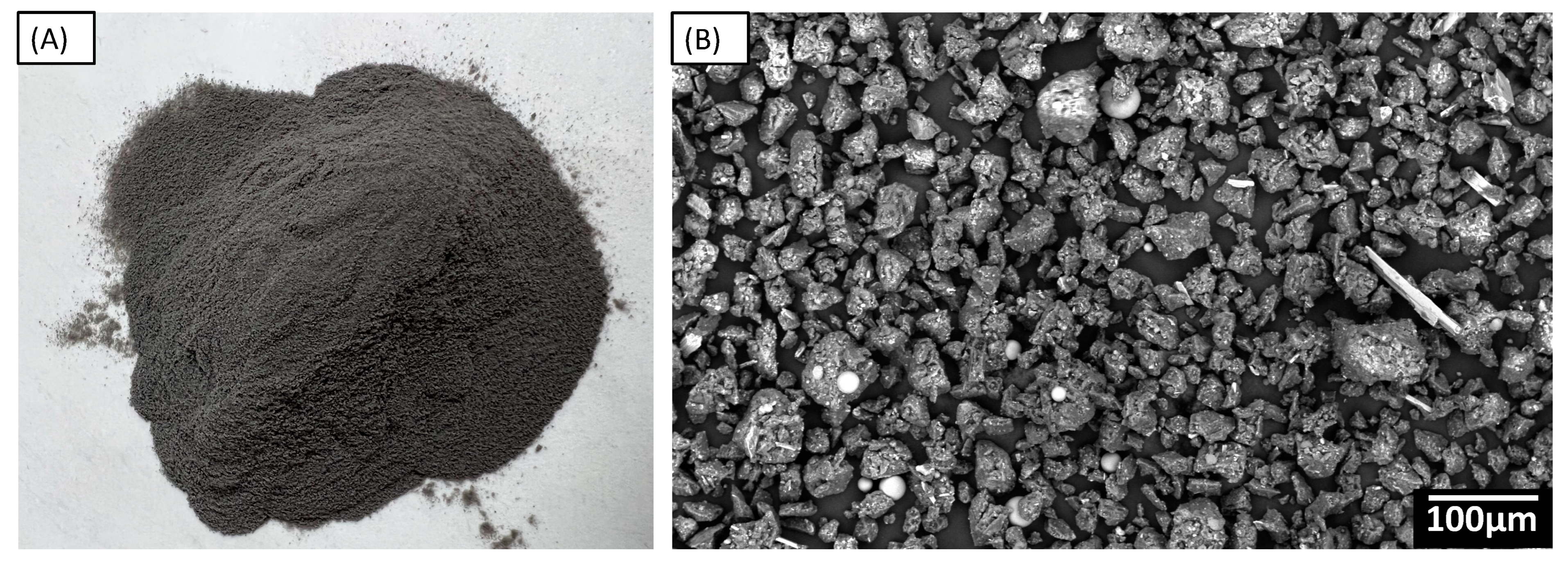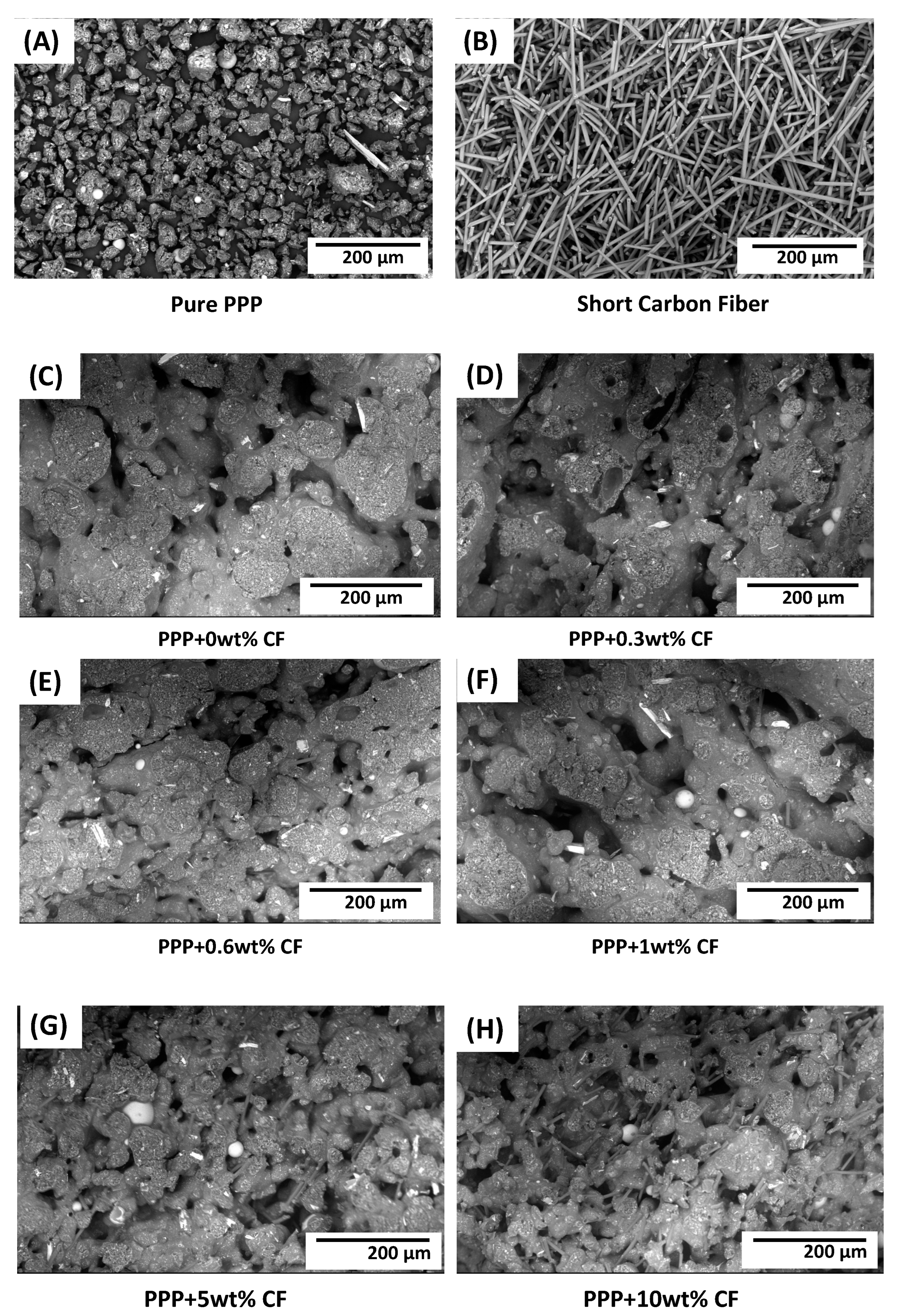Additive Manufacturing of Carbon Fiber Reinforced Epoxy Thermoset with Improved Thermomechanical Properties
Abstract
1. Introduction
2. Experimental Methodology
2.1. Materials
2.2. Preparation of PPP/CF Composite Powders
2.3. 3D Printing and Curing of PPP/CF Composites
2.4. Characterization
2.4.1. Thermal Property Analysis of PPP Matrix Material
2.4.2. Dynamic Mechanical Analysis of 3D Printed PPP/CF Composites
2.4.3. Mechanical Testing of 3D Printed PPP/CF Composites
2.4.4. Scanning Electron Microscopy of 3D Printed PPP/CF Composites
2.4.5. Powder Tap Density and Sample Density
3. Result and Discussion
3.1. Particle Morphology of PPP Matrix Material
3.2. Thermal Properties of PPP Matrix Material
3.3. Effect of Carbon Fiber on Mechanical Properties of 3D Printed Parts
3.4. Effect of Carbon Fiber on Thermomechanical Properties of 3D Printed Parts
3.5. Powder Tap Density and Sample Density of PPP/CF Composites
3.6. Fracture Interface Observation of 3D Printed Samples
4. Conclusions
- (a)
- Compared with pure thermosetting plastics, fiber addition to polymer thermosetting matrices can improve Young’s modulus, flexural modulus, tap density, and sample density up to a certain amount (5 wt%) of CF.
- (b)
- Adding CF increased the storage modulus, loss modulus, and damping factor properties. Nevertheless, CF reinforcement has no impact on Tg points.
- (c)
- Specimen with 5 wt% CF had the most significant mean value of Young’s modulus and flexural modulus, which are 52.47% and 258.63% higher than the pure specimen, respectively.
- (d)
- SEM images revealed that specimens with higher than 5 wt% CF had severe porosity and poor wetting between CF and epoxy matrix, decreasing mechanical performance.
- (e)
- Powder tap density impacts powder flowability and sample density after the curing of the specimens. The tap density of epoxy thermoset powder and 3D printed fully cured sample density was improved by including CF reinforcement material up to 5 wt%.
Author Contributions
Funding
Data Availability Statement
Acknowledgments
Conflicts of Interest
References
- Pereira, T.; Kennedy, J.V.; Potgieter, J. A comparison of traditional manufacturing vs additive manufacturing, the best method for the job. Procedia Manuf. 2019, 30, 11–18. [Google Scholar] [CrossRef]
- Yap, Y.L.; Wang, C.; Sing, S.L.; Dikshit, V.; Yeong, W.Y.; Wei, J. Material jetting additive manufacturing: An experimental study using designed metrological benchmarks. Precis. Eng. 2017, 50, 275–285. [Google Scholar] [CrossRef]
- Regis, J.E.; Renteria, A.; Hall, S.E.; Hassan, S.; Marquez, C.; Lin, Y. Recent Trends and Innovation in Additive Manufacturing of Soft Functional Materials. Materials 2021, 14, 4521. [Google Scholar] [CrossRef]
- Hassan, S.; Zaman, S.; Rodriguez, A.; Molina, L.; Dominguez, C.E.; Morgan, R.; Bernardin, J.; Lin, Y. Direct ink write 3D printing of wave propagation sensor. Flex. Print. Electron. 2022, 7, 045011. [Google Scholar] [CrossRef]
- Ziaee, M.; Crane, N. Binder Jetting: A Review of Process, Materials, and Methods. Fac. Publ. Available online: https://scholarsarchive.byu.edu/facpub/5357 (accessed on 1 August 2019).
- Pagac, M.; Hajnys, J.; Ma, Q.-P.; Jancar, L.; Jansa, J.; Stefek, P.; Mesicek, J. A Review of Vat Photopolymerization Technology: Materials, Applications, Challenges, and Future Trends of 3D Printing. Polymers 2021, 13, 598. [Google Scholar] [CrossRef]
- Hassan, S.; Chavez, L.A.; Chou, C.-C.; Hall, S.E.; Tseng, T.-L.; Lin, Y. Mechanical response of shape-recovering metamaterial structures fabricated by additive manufacturing. Mater. Res. Express 2021, 8, 115801. [Google Scholar] [CrossRef]
- ISO/ASTM 52900:2021(en). Additive Manufacturing—General Principles—Fundamentals and Vocabulary. Available online: https://www.iso.org/obp/ui/#iso:std:iso-astm:52900:ed-2:v1:en (accessed on 2 April 2023).
- Frketic, J.; Dickens, T.; Ramakrishnan, S. Automated manufacturing and processing of fiber-reinforced polymer (FRP) composites: An additive review of contemporary and modern techniques for advanced materials manufacturing. Addit. Manuf. 2017, 14, 69–86. [Google Scholar] [CrossRef]
- Singh, D.D.; Arjula, S.; Reddy, A.R. Functionally Graded Materials Manufactured by Direct Energy Deposition: A review. Mater. Today Proc. 2021, 47, 2450–2456. [Google Scholar] [CrossRef]
- Diaz, J.C.; Watanabe, K.; Rubio, A.; De La Cruz, A.; Godinez, D.; Nabil, S.T.; Murr, L.E.; Wicker, R.B.; Arrieta, E.; Medina, F. Effect of Layer Thickness and Heat Treatment on Microstructure and Mechanical Properties of Alloy 625 Manufactured by Electron Beam Powder Bed Fusion. Materials 2022, 15, 7767. [Google Scholar] [CrossRef] [PubMed]
- Hassan, S.; Billah, K.M.M.; Hall, S.E.; Sepulveda, S.; Regis, J.E.; Marquez, C.; Cordova, S.; Whitaker, J.; Robison, T.; Keating, J.; et al. Selective Laser Sintering of High-Temperature Thermoset Polymer. J. Compos. Sci. 2022, 6, 41. [Google Scholar] [CrossRef]
- Chavez, L.A.; Ibave, P.; Hassan, S.; Hall-Sanchez, S.E.; Billah, K.M.M.; Leyva, A.; Marquez, C.; Espalin, D.; Torres, S.; Robison, T.; et al. Low-temperature selective laser sintering 3D printing of PEEK-Nylon blends: Impact of thermal post-processing on mechanical properties and thermal stability. J. Appl. Polym. Sci. 2022, 139, 52290. [Google Scholar] [CrossRef]
- Aversa, A.; Lorusso, M.; Cattano, G.; Manfredi, D.; Calignano, F.; Ambrosio, E.P.; Biamino, S.; Fino, P.; Lombardi, M.; Pavese, M. A study of the microstructure and the mechanical properties of an Al Si Ni alloy produced via selective laser melting. J. Alloys Compd. 2017, 695, 1470–1478. [Google Scholar] [CrossRef]
- Hassan, S.; Billah, K.M.M.; Hall, S.E.; Sepulveda, S.; Regis, J.; Marquez, C.; Cordova, S.; Shafirovich, E.; Lin, Y. Selective laser sintering of high temperature thermoset. In Behavior and Mechanics of Multifunctional Materials XVI; SPIE: Bellingham, DA, USA, 2022; Volume 12044, pp. 58–78. [Google Scholar] [CrossRef]
- Kafle, A.; Luis, E.; Silwal, R.; Pan, H.M.; Shrestha, P.L.; Bastola, A.K. 3D/4D Printing of Polymers: Fused Deposition Modelling (FDM), Selective Laser Sintering (SLS), and Stereolithography (SLA). Polymers 2021, 13, 3101. [Google Scholar] [CrossRef]
- Mehdipour, F.; Gebhardt, U.; Kästner, M. Anisotropic and rate-dependent mechanical properties of 3D printed polyamide 12—A comparison between selective laser sintering and multi jet fusion. Results Mater. 2021, 11, 100213. [Google Scholar] [CrossRef]
- Schmid, M.; Amado, A.; Wegener, K. Polymer powders for selective laser sintering (SLS). In AIP Conference Proceedings; AIP Publishing LLC: Melville, NY, USA, 2015. [Google Scholar] [CrossRef]
- Greiner, S.; Wudy, K.; Lanzl, L.; Drummer, D. Selective laser sintering of polymer blends: Bulk properties and process behavior. Polym. Test. 2017, 64, 136–144. [Google Scholar] [CrossRef]
- Jing, W.; Hui, C.; Qiong, W.; Hongbo, L.; Zhanjun, L. Surface modification of carbon fibers and the selective laser sintering of modified carbon fiber/nylon 12 composite powder. Mater. Des. 2017, 116, 253–260. [Google Scholar] [CrossRef]
- Hall, S.E.; Centeno, V.; Favela, S.; Lopez, A.; Gallardo, A.; Pellicotte, J.; Torres, Y.; Coverdell, D.; Torres, S.; Choudhuri, A.; et al. Mechanical Properties of High-Temperature Fiber-Reinforced Thermoset Composites with Plain Weave and Unidirectional Carbon Fiber Fillers. J. Compos. Sci. 2022, 6, 213. [Google Scholar] [CrossRef]
- Standard Test Method for Compositional Analysis by Thermogravimetry. Available online: https://www.astm.org/e1131-20.html (accessed on 12 June 2022).
- Standard Practice for Plastics: Dynamic Mechanical Properties: Determination and Report of Procedures. Available online: https://www.astm.org/d4065-20.html (accessed on 10 October 2022).
- Flexural Test Composites Four-Point Bending by ASTM D6272. Available online: https://www.intertek.com/polymers/composites/flexural-test-composites-four-point-bending-astm-d6272/ (accessed on 10 October 2022).
- Kinetics of Carbon Nanotube-Loaded Epoxy Curing: Rheometry, Differential Scanning Calorimetry, and Radio Frequency Heating|Request PDF. Available online: https://www.researchgate.net/publication/348208730_Kinetics_of_carbon_nanotube-loaded_epoxy_curing_Rheometry_differential_scanning_calorimetry_and_radio_frequency_heating (accessed on 9 June 2022).
- Sasaki, T.; Moriuchi, H.; Yano, S.; Yokota, R. High thermal stable thermoplastic–thermosetting polyimide film by use of asymmetric dianhydride (a-BPDA). Polymer 2005, 46, 6968–6975. [Google Scholar] [CrossRef]
- Rezaei, F.; Yunus, R.; Ibrahim, N.A. Effect of fiber length on thermomechanical properties of short carbon fiber reinforced polypropylene composites. Mater. Des. 2009, 30, 260–263. [Google Scholar] [CrossRef]
- Jacob, M.; Francis, B.; Thomas, S.; Varughese, K. Dynamical mechanical analysis of sisal/oil palm hybrid fiber-reinforced natural rubber composites. Polym. Compos. 2006, 27, 671–680. [Google Scholar] [CrossRef]
- Karsli, N.G.; Aytac, A. Tensile and thermomechanical properties of short carbon fiber reinforced polyamide 6 composites. Compos. Part B Eng. 2013, 51, 270–275. [Google Scholar] [CrossRef]
- Jallo, L.J.; Ghoroi, C.; Gurumurthy, L.; Patel, U.; Davé, R.N. Improvement of flow and bulk density of pharmaceutical powders using surface modification. Int. J. Pharm. 2012, 423, 213–225. [Google Scholar] [CrossRef] [PubMed]











| Process Parameter | Value |
|---|---|
| Laser Power in watt | 5 |
| Layer height (LH) in millimeters | 0.150 |
| Hatch spacing (HS) in millimeters | 0.36 |
| The full-layer feed ratio | 2.0 |
| Energy scale (ES) | 1.0 |
| Max energy per (MEP) cm3, infill | 700 |
| Constant energy (CE), infill | 0.8 |
| Max power depth (MPD), infill | 2.5 |
| Max energy per (MEP) cm3, perimeters | 700 |
| Constant energy (CE), perimeters | 0.8 |
| Max power depth (MPD), perimeters | 2.5 |
| Stages | Curing Temperature | Curing Period |
|---|---|---|
| 1 | 75 °C | 30 min |
| 2 | 85 °C | 30 min |
| 3 | 115 °C | 1 h |
| 4 | 185 °C | 1 h |
Disclaimer/Publisher’s Note: The statements, opinions and data contained in all publications are solely those of the individual author(s) and contributor(s) and not of MDPI and/or the editor(s). MDPI and/or the editor(s) disclaim responsibility for any injury to people or property resulting from any ideas, methods, instructions or products referred to in the content. |
© 2023 by the authors. Licensee MDPI, Basel, Switzerland. This article is an open access article distributed under the terms and conditions of the Creative Commons Attribution (CC BY) license (https://creativecommons.org/licenses/by/4.0/).
Share and Cite
Hassan, M.S.; Delgadillo, A.; Mahmud, M.S.; Munoz, J.; Zaman, S.; Gomez, S.G.; Marquez, C.; Ho, J.C.; Lin, Y. Additive Manufacturing of Carbon Fiber Reinforced Epoxy Thermoset with Improved Thermomechanical Properties. J. Compos. Sci. 2023, 7, 171. https://doi.org/10.3390/jcs7040171
Hassan MS, Delgadillo A, Mahmud MS, Munoz J, Zaman S, Gomez SG, Marquez C, Ho JC, Lin Y. Additive Manufacturing of Carbon Fiber Reinforced Epoxy Thermoset with Improved Thermomechanical Properties. Journal of Composites Science. 2023; 7(4):171. https://doi.org/10.3390/jcs7040171
Chicago/Turabian StyleHassan, Md Sahid, Antonio Delgadillo, Md Shahjahan Mahmud, Joseph Munoz, Saqlain Zaman, Sofia Gabriela Gomez, Cory Marquez, Johnny C. Ho, and Yirong Lin. 2023. "Additive Manufacturing of Carbon Fiber Reinforced Epoxy Thermoset with Improved Thermomechanical Properties" Journal of Composites Science 7, no. 4: 171. https://doi.org/10.3390/jcs7040171
APA StyleHassan, M. S., Delgadillo, A., Mahmud, M. S., Munoz, J., Zaman, S., Gomez, S. G., Marquez, C., Ho, J. C., & Lin, Y. (2023). Additive Manufacturing of Carbon Fiber Reinforced Epoxy Thermoset with Improved Thermomechanical Properties. Journal of Composites Science, 7(4), 171. https://doi.org/10.3390/jcs7040171









